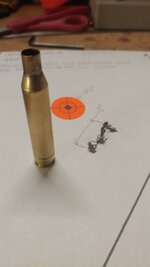My last range session I experienced some pressure signs, stiff bolt lift, case head crack and extractor impression. These were only on the loads I set back deeper to test so I wont do that again, plus I learned my rifle likes the bullet closest to the lands anyways. And it was random, other cartridge loads in the same set with the same setback were fine.
I was told somewhere that as brass is fired it hardens and thus shortens its life. Whats odd is I did not experience these pressure signs with the very same load recipe and bullet setback test until the 3rd time reusing the brass. I'm wondering if this is because of the brass hardening from use and becoming brittle or if Ive exceeded maximum charge and/or setback? I could back off on my powder charge weight except I'm not experiencing these pressure signs with the loads closest to the lands. Does annealing the brass before reloading it extend its life or are the pressure signs a symptom of overcharging or over seating or some other improper reloading technique?

I was told somewhere that as brass is fired it hardens and thus shortens its life. Whats odd is I did not experience these pressure signs with the very same load recipe and bullet setback test until the 3rd time reusing the brass. I'm wondering if this is because of the brass hardening from use and becoming brittle or if Ive exceeded maximum charge and/or setback? I could back off on my powder charge weight except I'm not experiencing these pressure signs with the loads closest to the lands. Does annealing the brass before reloading it extend its life or are the pressure signs a symptom of overcharging or over seating or some other improper reloading technique?












